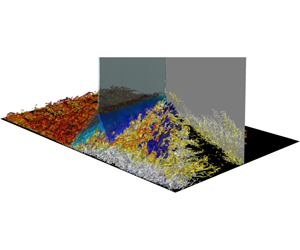Published online by Cambridge University Press: 08 June 2020

The mechanisms of unsteadiness in nominally two-dimensional (2-D) shock/turbulent-boundary-layer interactions (STBLIs) cannot be directly extended to three-dimensional (3-D) STBLIs, because of differences in interaction structure; swept 3-D interactions, including the sharp-fin and swept-compression-ramp configurations, are of particular interest in this work. Complications arise from the observation that the separation length employed to scale low-frequency unsteadiness in 2-D (spanwise homogeneous) interactions is not a global property of 3-D (swept) interactions, due to the quasi-conical symmetry of the latter. Also, flow separation in 3-D interactions is topologically different, in that closure of the primary separation cannot occur without breaking the quasi-conical symmetry of the interaction – consequently, the unsteady properties of the separation are different. To address these points, large-eddy simulations are performed to assess unsteadiness in 3-D interactions, with the aim of understanding key differences relative to analogous 2-D interactions, the former of which have received less attention in the literature. The mechanism underlying the prominent band of low-frequency unsteadiness (two decades below the characteristic boundary-layer frequency) is shown to be significantly muted in swept interactions. An interesting scaling for the band of mid-frequency unsteadiness is uncovered (at least one decade below the characteristic boundary-layer frequency). This is a consequence of the observed connection between coherent fluctuations in the separated shear layer and local mean-flow gradients, indicating a mix between competing 2-D and 3-D free-interaction scaling laws. In contrast, high-frequency fluctuations largely retain the 2-D scaling introduced by the incoming turbulent boundary layer. The spatial structure of the mid-frequency coherence in 3-D STBLIs is isolated, revealing the significant influence of these convective coherent structures on shock rippling/corrugation, as well as a spanwise dependence of coherence size consistent with the 3-D mean-flow similarity scaling. Finally, the dynamic linear response of a representative 3-D interaction is compared to that of a representative 2-D interaction; the absolute instability present in the 2-D interaction is not present in the 3-D interaction. The coincident absence of both the absolute instability and associated band of low-frequency unsteadiness in 3-D STBLIs underscores the significance of this absolute instability in facilitating low-frequency unsteadiness in 2-D interactions.